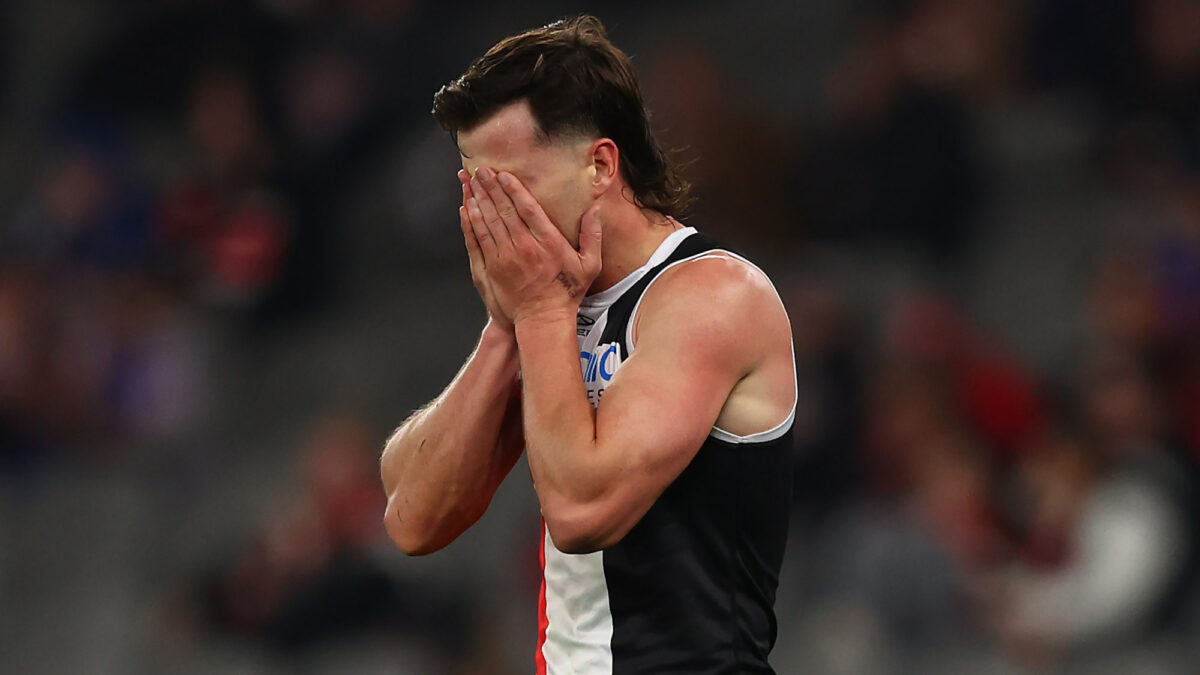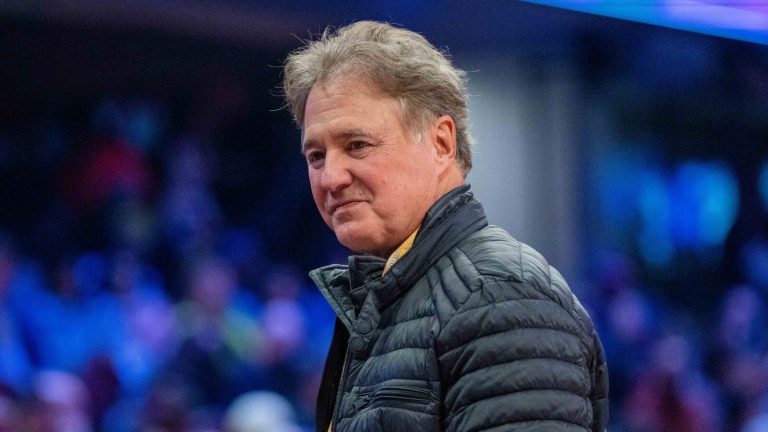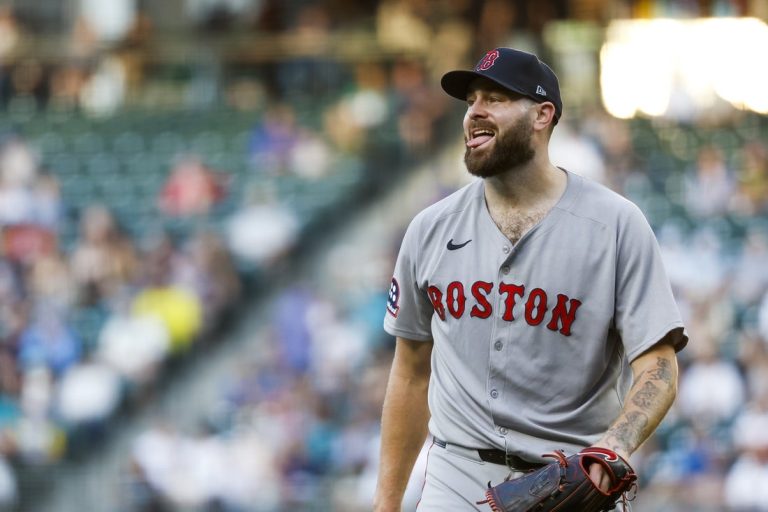There was a moment in the second quarter on Thursday night that couldn’t have been a more perfect metaphor for where St Kilda find themselves at the moment.
After taking a kick-in, Nasiah Wanganeen-Milera, the Saints’ most gifted player, worked his backside off to sprint to the wing, receive a handball from Liam Stocker, and continue to dash his way forward.
Taking three bounces, he carries the ball all the way to half-forward for the Saints, some 130 metres from his initial kick-in; but too late, he realise he’s run himself into trouble with the Dogs corralling him to the boundary line , the ball having moved too quickly for the forward to be set up in any meaningful way.
Suddenly desperate, and lacking a left foot to drive the ball long, he attempts a checkside scrubbing kick inboard, and it backfires spectacularly; Jack Macrae fumbles a difficult gather, the ball bobbles clear, and Adam Treloar begins a chain that takes the Bulldogs all the way up the other end for Sam Darcy to mark opposed, somehow, to Zak Jones inside 50. Goal Dogs.
This is the St Kilda of 2025 under Ross Lyon in a nutshell: a team not short of dare, or desire, or pace, but fundamentally ending up where they have been for the better part of the last 15 years. Absolutely nowhere.
The Saints’ hefty 72-point loss to the Bulldogs, a near mirror image of the 71-point hiding they were dealt back in Round 6, nicely sums up where they sit in footy’s pecking order.
The Dogs, as we learned last week, are a team whose strengths as as destructive as any team in the AFL; but if their handball game and spread from stoppages are shut down, as Hawthorn did perfectly, they lack a Plan B to get the game on their terms or even break even against quality opponents.
There was no such pressure applied to the Bulldogs’ midfield on this Thursday night – the Saints lack the class, the leg speed, and maybe the structure as well, to clamp down on the things that have seen the Dogs run up the score on weaker teams in 2025 with monotonous regularity.
That left their defence, for the most part, only needing to defend long, high, slow balls coming at them, providing a feast for Rory Lobb and Bailey Williams in particular – and with Jack Higgins almost invisible, threats at ground level were minimal and no one seemed all that interested in shutting down the run and carry of Bailey Dale, whose 36 disposals were the most on the field.
Up forward, Sam Darcy was the cheat code he was to start the year before his knee injury, but more damning for the Saints were their struggles against Aaron Naughton and Buku Khamis, who bagged five goals between them after being repeatedly hit on the lead by Dogs midfielders under minimal pressure and given huge amounts of space to work with inside 50.
The irony in all of this is that the Dogs actually had a worse night at stoppages than against the Hawks, only winning the clearance count by one and losing 15-13 from centre breaks – which, incidentally, was the Saints’ most likely method of scoring all evening long.
But where the Hawks’ ferocious pressure and rigid adherence to denying the Dogs any room to breathe, they dominated the territory battle – something the Saints, with just 41 inside 50s to 68, were incapable of.
The excuse from Ross Lyon will likely be that his team is a young one, still developing, with plenty of work to be done – but their average age and games played both, thanks to the return of Jack Macrae from his punctured lung, is actually higher than the Hawks against the Dogs last week.
More than half the team, compared to the Hawks’ 10, had played 100 games, too.
The Hawks’ excellence last week was borne of players in their prime – Jai Newcombe, at 23, was a poular choice for best-afield honours, while Dylan Moore (25), Jack Ginnivan (22), Lloyd Meek (27) and Mabior Chol (28) were likewise outstanding.
The Saints are glaringly lacking in that age range: their best players are either on the wrong side of 30, in Sinclair and Jack Macrae, or near enough, as are the 29-year olds Rowan Marshall, Callum Wilkie and Jack Steele.
Of the youngsters, Nasiah Wanganeen-Milera has been wonderful this season, but of his 21 first-half disposals against the Bulldogs I counted five that directly resulted in Dogs scores, with his kicking far more frequently disastrous than a player of his talent has any right to produce.
Marcus Windhager did a tremendous job tagging Marcus Bontempelli – though wasn’t as effective offensively as when he shut Kysaiah Pickett down in the Saints’ win over Melbourne – but if a tagger is your best midfielder in any match, you’re probably in trouble.
Hunter Clark is into his eighth year, and I still don’t think either he or Ross Lyon really know what his best position is at AFL level yet: having looked on track as an on-baller in recent weeks, Macrae’s return saw him shunted, once again, to half-back, where he’s neither an interceptor, nor a rebounder, nor a lockdown player.
The Dogs, at least, champion versatility in their players: Bailey Williams has made a wing his own in the last two years, yet shifted to half-back against the Saints, he racked up a whopping 17 marks, plenty of them intercepts, plenty of them in a wonderful first quarter in which he proved impassable in the air.
Luke Beveridge has always been a sucker for flipping the magnets, and the Dogs on Thursday night have examples by the dozens: Lobb, Dale and even James O’Donnell have been transformed into defenders, Ed Richards a revelation over the last 12 months as a line-breaking midfielder, Aaron Naughton a junior backman made into a key forward, and the list goes on.
Say what you will about Beveridge, but it’s that kind of inventiveness that is glaringly lacking from Lyon’s Saints – and the result is a team completely and utterly stuck in no-man’s land, desperate to lure in a big fish on an enormous pay cheque, or a breakout superstar as a top draft pick, that seem unlikely to ever come.
The limit of Lyon’s ingenuity seems to be switching Anthony Caminiti and Isaac Keeler from one end to the other at half time, which yielded as much as shuffling deckchairs on the Titanic.
Why not trial Mitch Owens, the Saints’ most promising youngster two years ago now regularly struggling to impact as a mid-sized forward, as a permanent midfielder? Or Jack Sinclair, as he was for a good chunk of 2024, around the ball rather than off half-back, especially for as long as Wanganeen-Milera is around as the resident distributor down there?
This is the conundrum the Saints find themselves in: their midfield are uniformly past their prime, so much is reliant on Callum Wilkie in defence, and the forward line looks too often lacklustre unless given plentiful supply from further afield, which against good teams is a rarity.
Lyon has never undertaken a rebuild of this magnitude: his first stint at St Kilda saw him depart for greener pastures right as the cliff was reached, while when the bottom fell out at Fremantle after years of premiership contention, four poor years ensued before he was at last shown the door with the Dockers still some distance away from September action.
The Saints at the end of 2022 considered themselves a team with all the building blocks in place to have a run at deep finals action, a belief reinforced by a superb start to 2023 and sixth place on the ladder, even if an elimination final exit was the grand total.
Since then, though, Lyon has preached patience and lamented the limitations of his list … all the while continuing to grant games and key roles to the likes of Zak Jones – honest toilers who can be relied upon to do a job, but the sort of player any good team moves on the second they become so.
Or, to be brutally honest, Bradley Hill, who produced one of the more pathetic efforts on the mark I’ve ever seen to allow Joel Freijah to waltz past him for a tone-setting first quarter goal. The contrast to what the Hawks did to the Bulldogs was never starker than here.
Lyon may still be an excellent coach; he may be squeezing every last drop out of a poor Saints team.
But as it stands, this neither feels like a team rebuilding with the future in the hands of the youth, nor one anywhere near finals contention, never mind competing for a flag. And it’s that mediocre status that rests firmly on the coach’s shoulders. They are nowhere, it seems, by design.
The Bulldogs have been an accurate measurer of their rivals’ quality this year – good teams have uniformly beaten them, while ordinary or bad ones have been put to the sword.
The Saints, most assuredly, are in the latter camp – and unlike Richmond, or Melbourne, or even Sydney, there’s not a lot of evidence that light at the end of the tunnel is anywhere nearby, or likely to shine all that bright if and when it does arrive.






